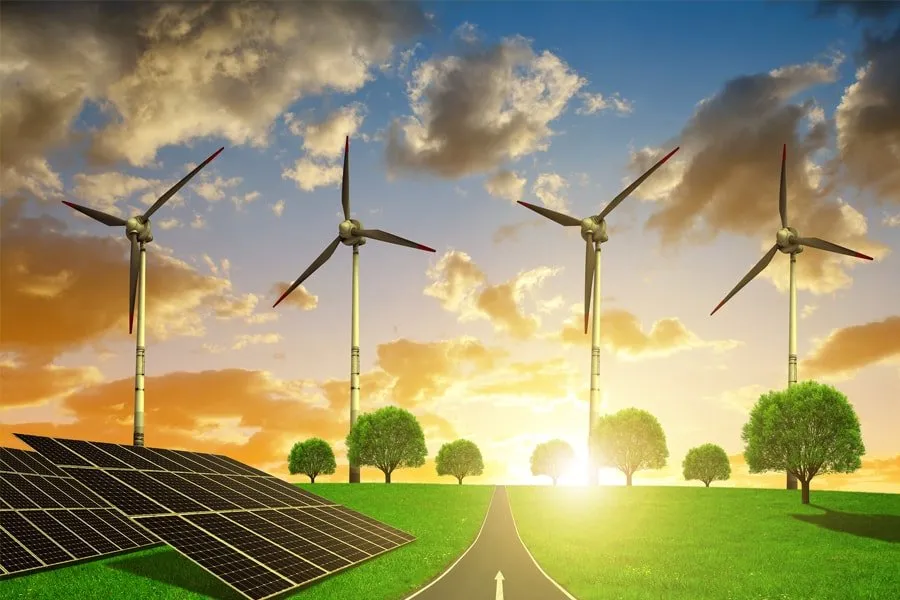With the UK and the US setting ambitious targets to achieve net zero carbon emissions by 2050, renewable energy has become a crucial part of the strategy to reduce our carbon footprint. But what exactly is renewable energy, and what different types are there? Let’s discuss the key sources of renewable energy, their benefits, and how they differ from non-renewable energy.
What is Renewable Energy?
Renewable energy comes from sources that are naturally replenishing and won’t run out. These sources have a much lower carbon footprint compared to fossil fuels, which are the primary contributors to greenhouse gas emissions. Examples of renewable energy include wind power, solar power, bioenergy, and hydroelectric power, including tidal energy.
Burning fossil fuels to generate electricity has had a significant impact on our climate, leading to increased carbon emissions. Renewable energy offers a cleaner alternative and is vital in the fight against climate change.
The Most Common Renewable Energy Sources
Let’s dive into the four main types of renewable energy used in the UK and explore how they contribute to our electricity mix.
Wind Power
Wind power is the largest producer of renewable electricity in both the UK and the US. Wind farms, whether onshore or offshore, use wind turbines to generate electricity. As the wind spins the turbine blades, kinetic energy is converted into electrical energy through a series of mechanical processes involving a drive shaft, a gearbox, and a generator. The electricity is then fed into the national grid.
Wind power has been expanding rapidly due to its efficiency and potential to generate large amounts of energy. However, its success depends on consistent wind patterns, which can vary by location and time of year.
Solar Power
Solar power is derived from sunlight, one of the most abundant energy resources on our planet. Despite this abundance, solar energy isn’t always the top source due to variations in sunlight based on location, season, and time of day.
Solar panels capture sunlight and convert it into electricity through a process known as the photovoltaic effect. This technology has become more accessible and efficient, making solar power a popular choice for renewable energy.
Hydroelectric Power
Hydroelectric power harnesses the energy from flowing or falling water to generate electricity. Dams and hydroelectric plants use underwater turbines to convert water’s kinetic energy into electrical energy. This category also includes wave and tidal power, which rely on ocean forces to generate electricity at the mouths of large bodies of water.
Hydroelectric power is a reliable source of renewable energy, but constructing dams can have environmental impacts, and tidal power can be limited by specific geographical locations.
Bioenergy
Bioenergy involves generating electricity by burning organic matter, known as biomass, such as plants, timber, or food waste. Although carbon dioxide is emitted during the process, bioenergy is considered renewable because these organic materials can be regrown and, over their lifespan, absorb as much carbon as they emit.
Bioenergy can be controversial due to the emissions it produces, but it’s still considered a renewable source because it relies on regrowable resources.
Non-Renewable Energy Sources
While renewable energy is gaining momentum, non-renewable sources like fossil fuels remain a significant part of our energy mix. Fossil fuels, including coal, natural gas, and oil, are finite resources that take hundreds of thousands of years to form. Extracting and burning them emits harmful greenhouse gases, contributing to climate change.
The Benefits of Renewable Energy
Why is renewable energy so important? Let’s discuss the key benefits:
- Abundant Supply: Unlike fossil fuels, renewable energy sources are plentiful and continuously replenishing.
- Reduced Emissions: Renewable energy produces little or no harmful emissions, helping to combat climate change.
- Sustainability: By using renewable sources, we can reduce our reliance on finite resources and create a more sustainable energy system.
These benefits underscore why governments worldwide are pushing for greater adoption of renewable energy.
Renewable Energy vs. Clean and Green Energy
Although the terms “green energy,” “clean energy,” and “renewable energy” are often used interchangeably, there’s a subtle difference:
- Clean Energy: This produces electricity without emissions, but its manufacturing or maintenance might have a carbon cost.
- Green Energy: This comes from entirely natural sources with low or no environmental impact in their creation or use.
- Renewable Energy: This comes from sources that can’t be depleted.
Most green energy sources are renewable, but not all renewable energy sources are necessarily green.
Renewable Energy in the Modern Era
The use of renewable energy has grown significantly in recent years. Let’s talk about some milestones:
- In 1991, renewable energy accounted for just 2% of electrical generation in the UK. By 2013, it had risen to 14.6%.
- In 2020, renewables made up 43.1% of the UK’s electricity mix, surpassing natural gas (34.5%) and coal (1.8%).
These statistics show that we’re on the right path, but there’s still work to be done. Increasing the use of renewable energy will be crucial in achieving net zero goals and combating climate change. Would you like to explore more about how renewable energy is being implemented in different countries or what future technologies might impact renewable energy?
